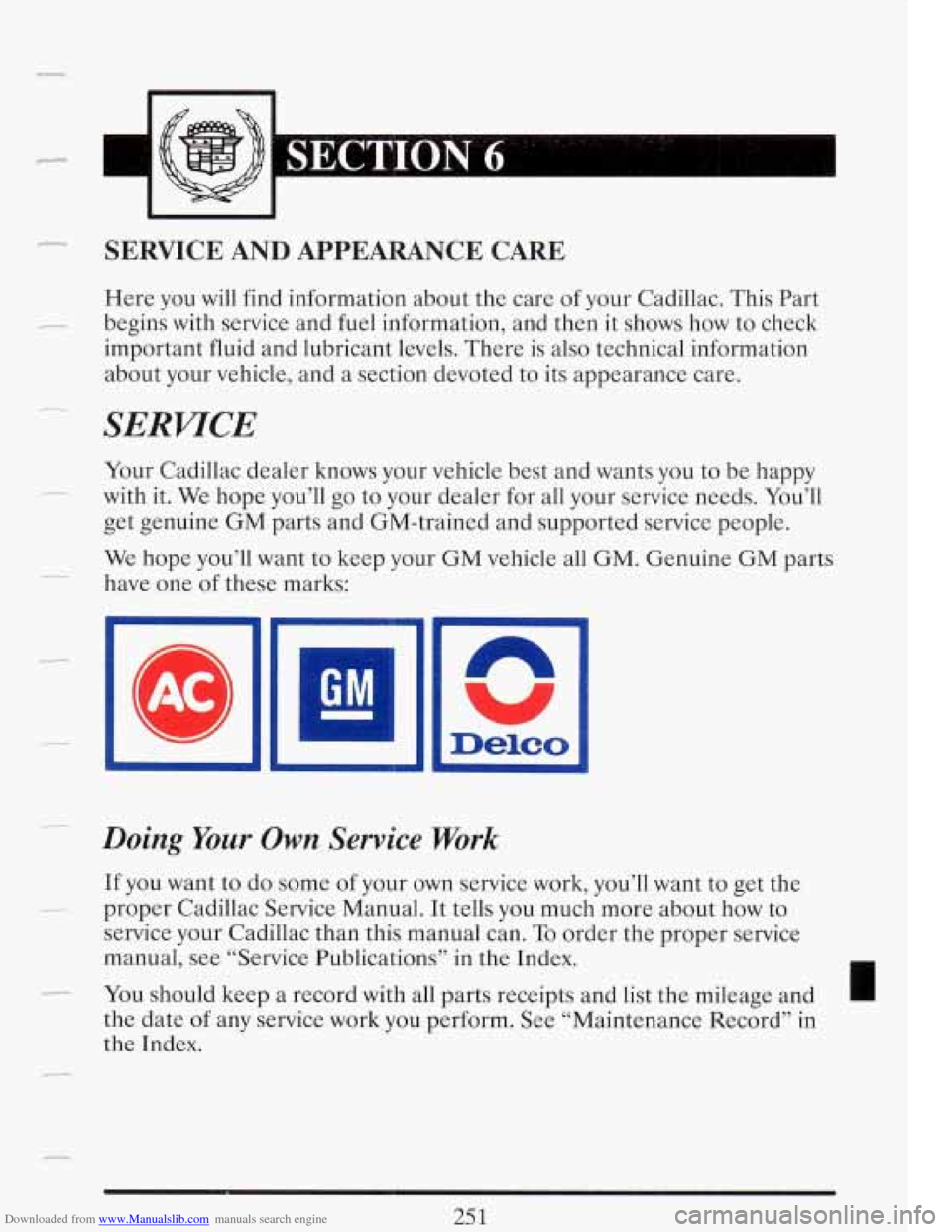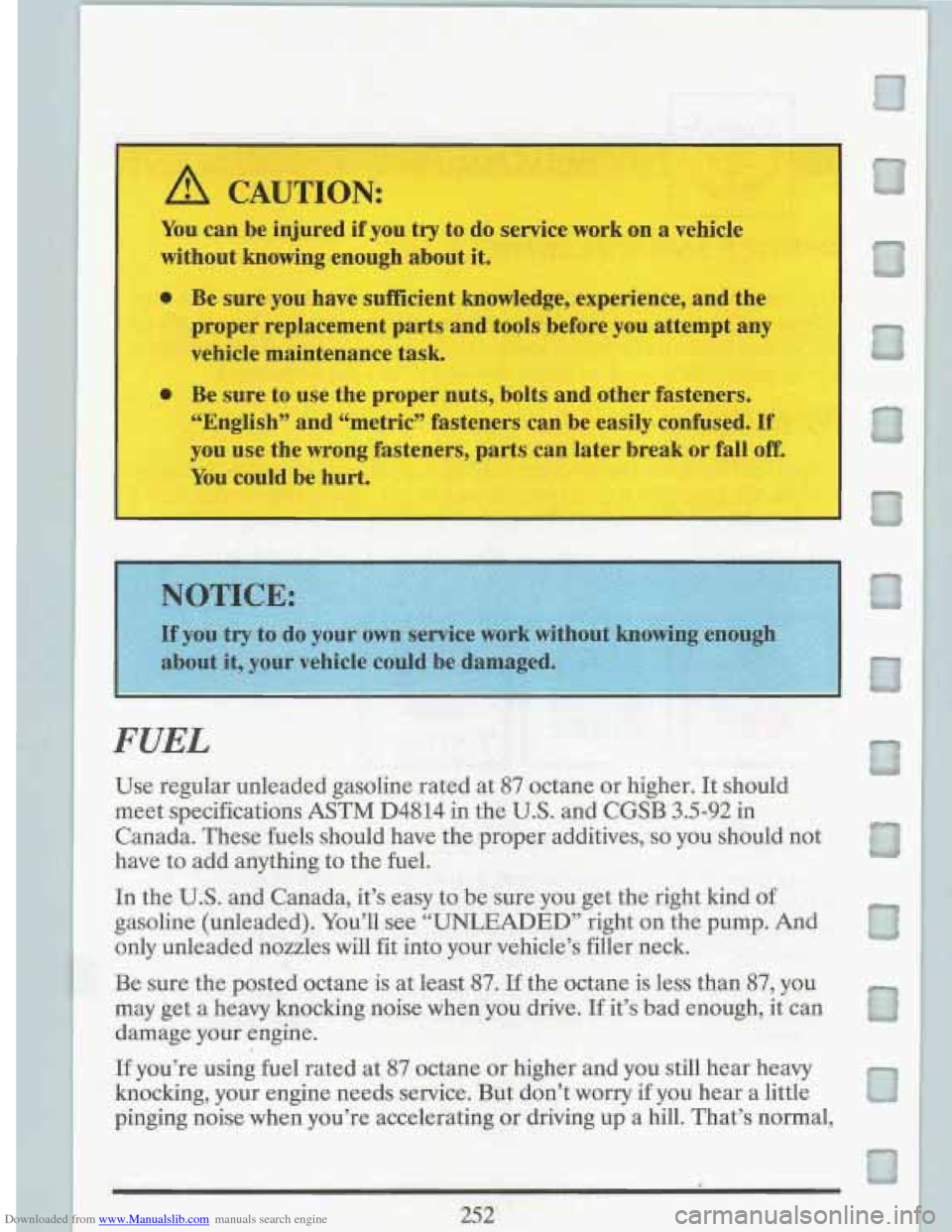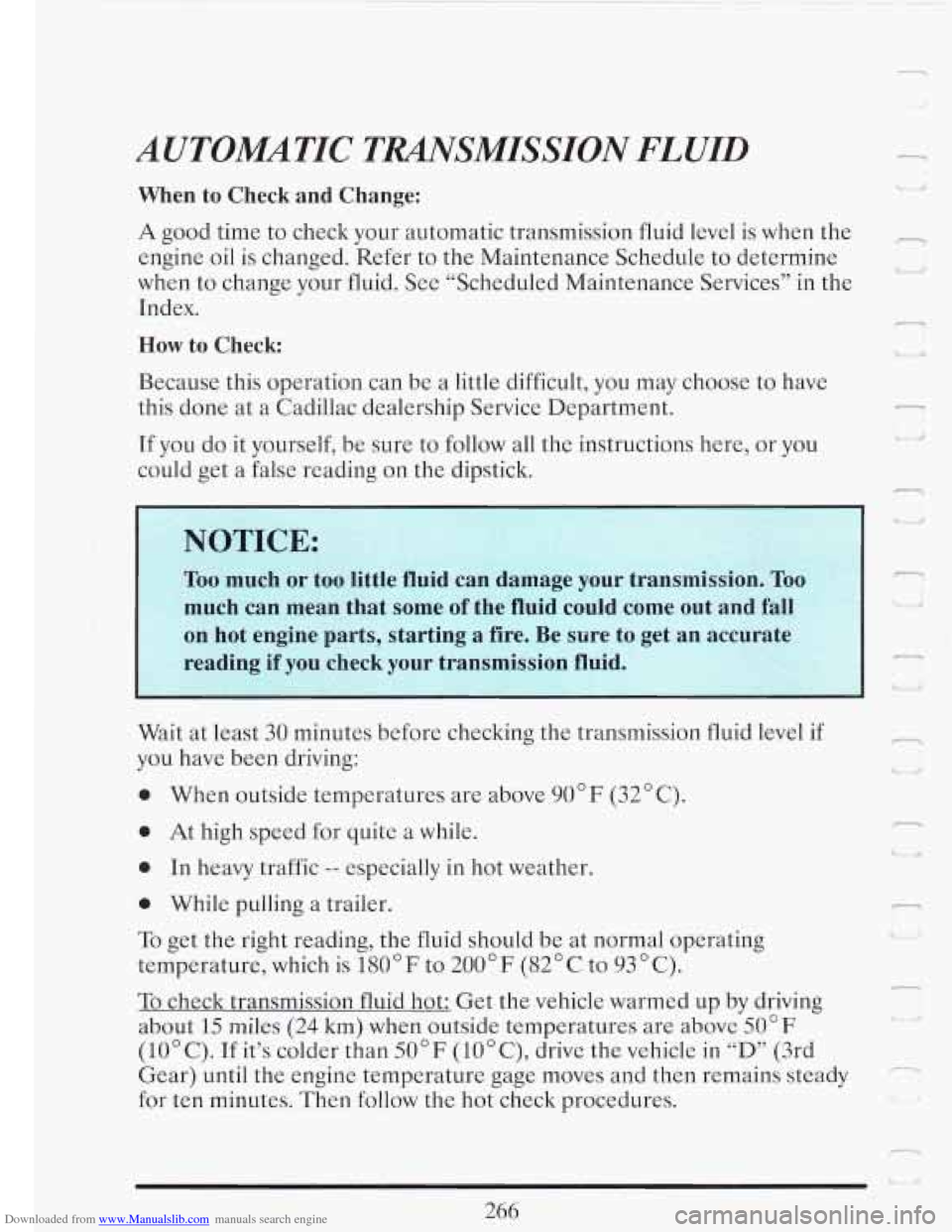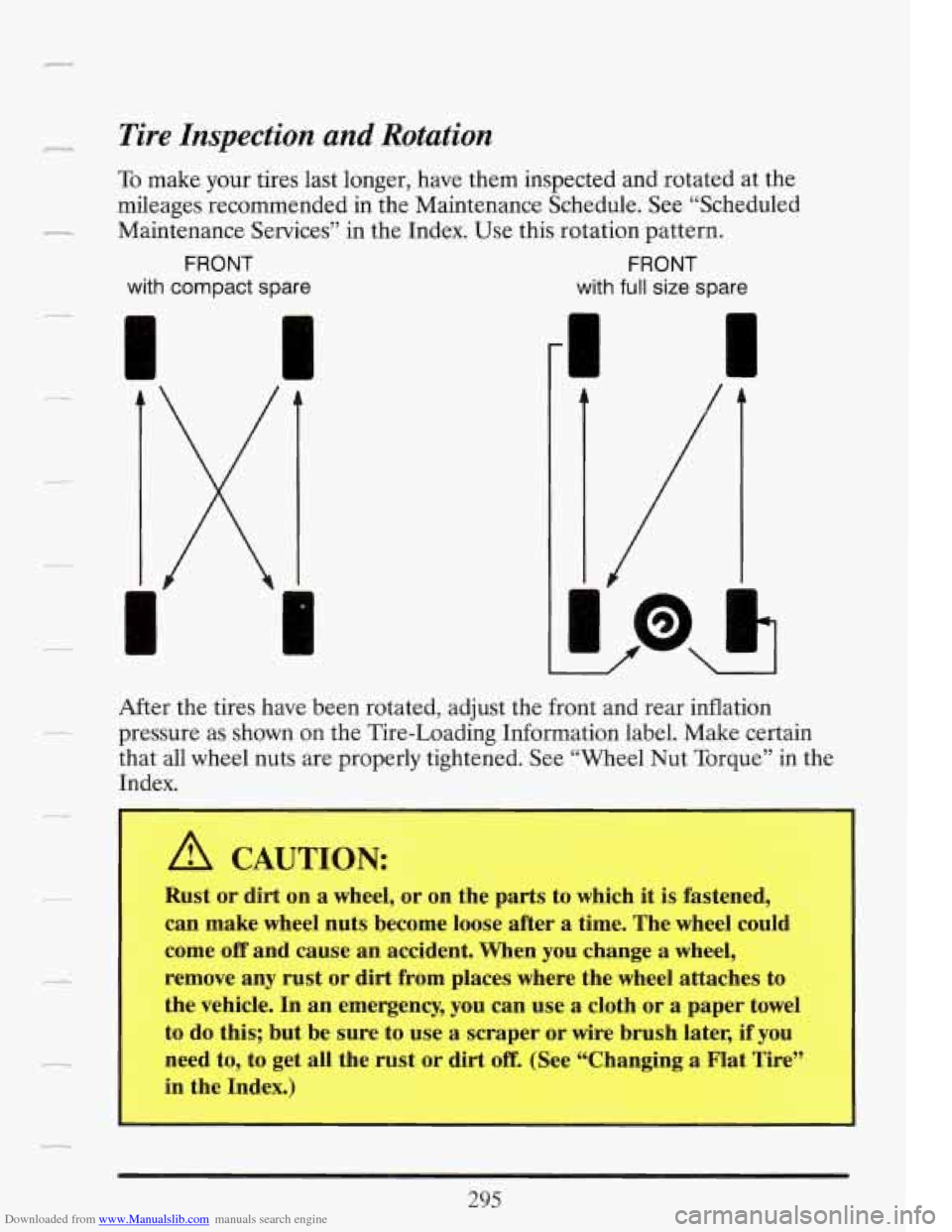Page 265 of 386

Downloaded from www.Manualslib.com manuals search engine r
SERVICE AND APPEARANCE CARE
Here you will find information about the care of your Cadillac. This Part
begins with service and fuel information, and then it shows how to check
important fluid and lubricant levels. There is also technical information
about your vehicle, and a section devoted to its appearance care.
SERWCE
Your Cadillac dealer knows your vehicle best and wants you to be happy
with it. We hope you’ll go to your dealer for all your service needs. You’ll
get genuine GM parts and GM-trained and supported service people.
We hope you’ll want to keep your GM vehicle all GM. Genuine GM parts
have one of these marks:
w wu
A
Doing Your Own Service Work
If you want to do some of your own service work, you’ll want to get the
service your Cadillac than this manual can.
To order the proper service
manual, see “Service Publications” in the Index.
- proper Cadillac Service Manual. It tells you much more about how to
,- You should keep a record with all parts receipts and list the mileage and I
the date of any service work you perform. See “Maintenance Record” in
the Index.
25 1
Page 266 of 386

Downloaded from www.Manualslib.com manuals search engine A CAUTION:
You can be injured if you try to do service work on a vehicle
without knowing enough about it.
0 Be sure you have sufficient knowledge, experience, and the
proper replacement parts and tools before you attempt any
vehicle maintenance task.
0 Be sure to use the proper nuts, bolts and other fasteners.
“English” and “metric” fasteners can be easily confused.
If
you use the wrong fasteners, parts can later break or fall off.
You could be hurt.
1DOUt
FUEL
Use regular unleaded gasoline rated at 87 octane or higher. It should
meet specifications
ASTM D4814 in the U.S. and CGSB 3.5-92 in
Canada. These fuels should have the proper additives,
so you should not
have to add anything to the fuel.
1 the U.S. and Canada, it’s easy to be sure you get the right kind of
gasoline (unleaded). You’ll see
“UNLEADED” right on the pump. And
only unleaded nozzles will fit into your vehicle’s filler neck.
Be sure the posted octane is at least
87. If the octane is less than 87, you
may get a heavy knocking noise when you drive. If it’s bad enough, it can
damage your engine.
If you’re using fuel rated at
87 octane or higher and you still hear heavy
knocking, your engine needs service. But don’t worry if you hear a little
pinging noise when you’re accelerating
or driving up a hill. That’s normal,
Page 268 of 386

Downloaded from www.Manualslib.com manuals search engine You should ask your service station operators if their gasolines contain
detergents and oxygenates, and if they have been reformulated to reduce
vehicle emissions.
FUELS IN FOREIGN COUNTMES
If you plan on driving in another country outside the U.S. or Canada,
unleaded fuel may be hard to find.
Do not use leaded gasoline. If you use
even one tankful, your emission controls won’t work well or at all. With
continuous use, spark plugs can get fouled, the exhaust system can
corrode, and your engine
oil can deteriorate quickly. Your vehicle’s
oxygen sensor
will be damaged. All of that means costly repairs that
wouldn’t be covered by your warranty.
To check on fuel availability, ask an auto club, or contact a major oil
company that does business in the country where you’ll be driving.
You can also write us at the following address for advice. Just tell
us
where you’re going and give your Vehicle Identification Number (VIN).
General Motors of Canada Ltd.
International Export Sales
PO. Box 828
Oshawa, Ontario L1H 7N1, Canada
n
Li
c
L4 , ,t
‘i nl
254
Page 278 of 386

Downloaded from www.Manualslib.com manuals search engine Engine Block Heater Option: An engine block heater can be a big help if
you have to park outside in
very cold weather, 0°F (-18OC) or colder. If
your vehicle has this option, see “Engine Block Heater”
in the Index.
How
To Reset the Oil Life Indicator: After the oil has been changed,
you’ll need to reset your system.
To do that, turn the ignition switch to the
“ON” position with the engine stopped fully depress and release the
accelerator pedal
3 times within 5 seconds.
If the “CHANGE OIC‘ light comes on and stays on for 5 seconds, it did
not reset. You’ll need to reset the system again.
What to
Do with Used Oil:
A CAUTION:
Used engine oil contains things that have caused skin cancer in
laboratory animals. Don’t let used oil stay on your skin for very
long. Clean your skin and nails with soap and water, or a good
hand cleaner. Wash or properly throw away clothing or rags
containing used engine oil.
Used oil can be a real threat to the environment. If you change your own
oil, be sure to drain all free-flowing oil from the filter before disposal.
-
Don’t ever dispose of oil by pouring it on the ground, into sewers, or into
streams or bodies of water. Instead, recycle it by taking
it to a place that
collects used oil. If you have a problem properly disposing of your used
oil, ask your dealer, a service station or
a local recycling center for help.
1:
n
264
I
Page 279 of 386
Downloaded from www.Manualslib.com manuals search engine AIR CLEAlVER
Refer to the
Maintenance Schedule
to determine when to
replace the air filter.
.- See “Scheduled Maintenance Services” in the Index.
c- A CAUTION:
Operating the engine with the air cleaner off can cause you or
others to be burned. The
air cleaner not only cleans the air, it
engine backfires, you could be burned. Don’t drive with it off,
and be careful working on the engine with the air cleaner
off.
~ stops flame if the engine backfires. If it isn’t there, and the
265
Page 280 of 386

Downloaded from www.Manualslib.com manuals search engine AUTOMATIC TMSMISSION FLUID
When to Check and Change:
A good time to check your automatic transmission fluid level is when the
engine oil is changed. Refer to the Maintenance Schedule to determine
cpr
when to change your fluid. See “Scheduled Maintenance Services’’ in the
Index. -I
How to Check
BeC’%’uSe this operation can be a little difficult, you may choose to have
this done at a Cadillac dealership Service Department.
r IYI
”I If you do it yourself, be sure to follow all the instructions here, or you
could get a false reading on the dipstick.
p_
NOTICE:
I
Too much or too little fluid can damage your transmission.
much can mean that some of the fluid could come out and fall
on hot engine parts, starting
a fire. Be sure to get an accurate
reading if you check
your transmission fluid. I
l-
Wait at least 30 minutes before checking the transmission fluid level if
you have been driving:
0 When outside temperatures are above 90” F (32” C).
n !‘ b
0 At high speed for quite a while.
0 In heavy traffic -- especially in hot weather.
0 While pulling a trailer.
To get the right reading, the fluid should be at normal operating
temperature, which is
180°F to 200°F (82°C to 93OC).
To check transmission fluid hot: Get the vehicle warmed up by driving
about
15 miles (24 km) when outside temperatures are above 50°F
(10°C). If it’s colder than 50°F (lO°C), drive the vehicle in “D” (3rd
Gear) until the engine temperature gage moves and then remains steady
-
for ten minutes. Then follow the hot check procedures. t3
_L-
1 <- 1
266
Page 309 of 386

Downloaded from www.Manualslib.com manuals search engine P Tire Inspection and Rotation
To make your tires last longer, have them inspected and rotated at the
mileages recommended in the Maintenance Schedule. See “Scheduled
- Maintenance Services” in the Index. Use this rotation pattern.
FRONT FRONT
with compact spare
with full size spare
cs
r
A
I
After the tires have been rotated, adjust the front and rear inflation
pressure as shown on the Tire-Loading Information label. Make certain
that all wheel nuts are properly tightened. See “Wheel Nut Torque” in the
Index.
A CAUTION:
Rust or dirt on a wheel, or on the parts to which it is fastened,
can make wheel nuts become loose after a time. The wheel could
come
off and cause an accident. When you change a wheel,
remove any rust
or dirt from places where the wheel attaches to
the vehicle. In an emergency, you can use
a cloth or a paper towel
to do this; but be sure to use a scraper
or wire brush later, if you
need to, to get all the rust
or dirt off. (See “Changing a Flat Tire”
in the Index.)
295
Page 310 of 386

Downloaded from www.Manualslib.com manuals search engine When It’s Time for New Tires
You need a new tire if One
way to tell when
it’s time for new tires
is to check the
treadwear indicators,
which will appear
when your tires have
only
2/32 inch (1.6
mm) or less of tread
remaining.
You can see the indicators at three places around the tire.
0 You can see cord or fabric showing through the tire’s rubber.
The tread or sidewall is cracked, cut or snagged deep enough to show
cord or fabric.
0 The tire has a bump, bulge or split.
The tire has a puncture, cut, or other damage that can’t be repaired
well because of the size or location of the damage.
Buying New Tires
To find out what kind and size of tires you need, look at the Tire-Loading
Information label.
The tires installed on your vehicle when it was new had a Tire
Performance Criteria Specification (TPC Spec) number on each tire’s
sidewall. When you get new tires, get ones with that same TPC Spec
number. That way, your vehicle will continue to have tires that are
designed
to give proper endurance, handling, speed rating, traction, ride
and other things during normal service on your vehicle.
If your tires have
an all-season tread design, the
TPC number will be followed by a “MS”
(for mud and snow).
n I, Lrrl
n
U
i
r?,
u
n
296